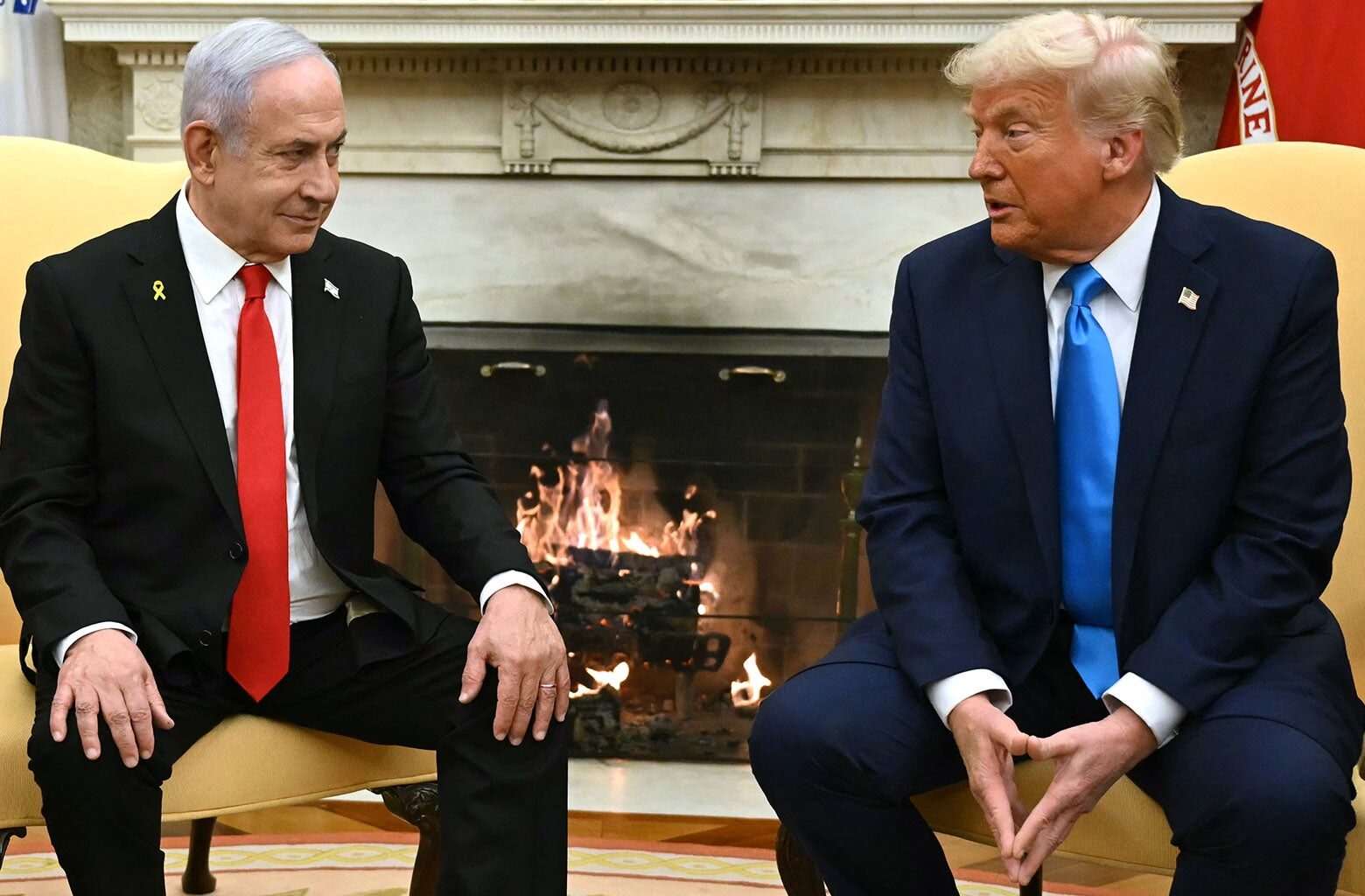Access is important. Slate is offering 6 months of Slate Plus to current and recently laid off federal government employees. If you, or someone you know, has been impacted, click here to get 6 months of Slate Plus free.
Donald Trump entered his second term as president with a demand to release all the Israeli hostages in Gaza and end the war, effectively forcing Prime Minister Benjamin Netanyahu into a ceasefire. But his call to empty Gaza of its 2 million residents and eventually build an American-controlled riviera there has become the centerpiece around which the flurry of ceasefire and “day after” diplomacy in Gaza is now revolving. Israel has since endorsed the idea, announcing plans to facilitate what it calls the “voluntary migration of Palestinians from Gaza”—though no country has agreed to take them.
On the face of it, Trump’s “Gaza plan,” which is about as realistic as the A.I. video he posted about it, has been politically useful to Netanyahu’s government: It has distracted from Israel’s failure to defeat Hamas over the past 15 months, and it ostensibly keeps the option of further, bloodier kinetic action open. At the same time, Trump’s push to complete the first phase of the hostage and ceasefire deal is a direct indictment of Netanyahu and his far-right coalition’s promise: that only military might will deliver “total victory,” an inherently amorphous and unattainable concept.
But the subtext of the president’s rhetoric is even more damning. It is an admission that Israel has failed to achieve its own declared war objectives of deposing Hamas and freeing the hostages. And the fact that the U.S. has been secretly speaking to Hamas directly makes Israel look like an obstacle.
Israel has debilitated Hamas’ military, but it has not extracted surrender—not in optics, nor on the ground. While Trump has emboldened the Israeli right by putting this extreme idea of America taking over Gaza and emptying it of Palestinians front and center, the reality in the territory remains stark: There are still 2 million Palestinians in Gaza, Hamas is still standing and still holding Israeli hostages, and no amount of military operations are likely to change that.
Israelis have watched with horror and joy over the past few weeks as hostages, old and young, soldiers and civilians, men and women, Arab and Jew, have emerged from the underground in Gaza and been put on Hamas stages before returning home. Most alive, some dead. It has become increasingly difficult to imagine Israel derailing the hostage deal now. As the entire country mourned for the Bibas children, it became clear most Israelis are clamoring for closure, healing, and introspection. A majority of Israelis not only want the hostage deal completed; they want the remaining hostages to be released all in one go, as Hamas has offered, in exchange for ending the war and full IDF withdrawal from the Strip. But if there’s something else most Israelis seem to agree on, it’s that you cannot leave Hamas in power in Gaza. At some point, they believe, Israel has to fight Hamas and win. But nobody in Israel seems to have a good answer for how to do that.
This is something Netanyahu and Israeli leadership cannot admit. Their approach—as articulated most explicity by far-right politicians Finance Minister Bezalel Smotrich and Itamar Ben-Gvir (the latter quit the coalition in protest when the ceasefire went into effect)—is rooted in the zero-sum use of force. Smotrich, who has threatened to leave Netanyahu’s government if Israel does not resume the war to destroy Hamas, suggests that Hamas can be defeated if Israel fully reoccupies the Strip, imposes military rule, and witholds all aid, arguing that aid is what keeps Hamas afloat. Netanyahu continues to promise the war goals will be achieved and recently reiterated that neither Hamas nor the Palestinian Authority will rule Gaza after the war. But he has said nothing about what could come in their stead. The U.S. is aligned with the Israeli position that Hamas cannot remain in power in Gaza, as both Middle East envoy Steve Witkoff and Secretary of State Marco Rubio have reiterated. The question is what exactly that means, and how it will be achieved.

Ruwaida Amer
The Menace in Gaza That’s Still Terrifying All of Us Here
Read More
Critics of Netanyahu’s war approach, primarily in Israel’s security establishment, blame his coalition for not creating conditions for an alternative to Hamas rule in Gaza. They want the military achievements to be followed by a political, diplomatic process to replace Hamas governance of Gaza. Some politicians in the opposition, like Yair Lapid or Democratic Party head Yair Golan (the inheritor of the remnants of the left-wing Labor and Meretz parties), have articulated a vision that relies entirely on Arab states taking ownership over the issue—as Trump has also implored them—by putting not just money but people on the ground. The idea is to secure reconstruction and administration of the Strip and see to it that Hamas does not govern or build itself back up in Gaza, while also ensuring that Israel does not attack Gaza. Egypt’s proposal for Gaza, endorsed by the Arab League in Cairo on March 4, attempts to do much of that, but it is thin on the issue of security and makes no mention of Hamas at all (which can be interpreted as either excluding Hamas or shirking the issue, specifically on Hamas arms). The proposal does clearly rebuff Trump’s transfer plan and Israel’s rejection of Palestinian statehood, by framing the plan within a path to a two-state solution. It also requires three actors to buy in: Hamas, Palestinian Authority President Abu Mazen, and the Israeli government. The latter has outright rejected the plan already and will only be compelled by outside pressure to go that course.
Israel is now threatening to resume the war if Hamas doesn’t agree to fully surrender or to extend the ceasefire and hostage-prisoner exchange without taking any further steps that the initial agreement required in Phase 2. Israel could fully occupy Gaza, as the far right demands, or it could conduct routine raids and strikes, as is its norm in the West Bank. The military would presumably be able to send in more troops now than previously, because it is not as bogged down in Lebanon (though hundreds of troops remain in several outposts on the border inside Lebanon, as well as in a new buffer zone in Syria). But those troops will be vulnerable to the same, and likely intensified, guerrilla warfare that Hamas has engaged in from the start of the war—the kind of fighting that claimed the lives of 16 soldiers in northern Gaza in just one week before the Jan. 19 ceasefire went into effect. Hamas will continue to hide in tunnels, of which around 50 percent are still Intact. The group isn’t fighting to win, just to survive another day. There is no reason to believe more of the same Israeli actions, even if stronger, will produce a different result.
So Israel’s position right now is weaker than it appears. The price for resuming its war in Gaza is high, and the benefits unclear. The reality on the ground in the West Bank, one of the most heavily surveilled places on earth, where Israel has ruled militarily for more than 50 years and is conducting its largest military campaign since the Second Intifada, is further evidence that Israeli actions have not worked beyond “mowing the grass” (a term the military has used to describe degrading armed groups in order to buy time and maintain the status quo between rounds of conflict).
This Content is Available for Slate Plus members only
What Trump’s $2 Billion Loss at the Supreme Court Really Tells Us
This Content is Available for Slate Plus members only
The Courts Just Got Rid of the Last Person Standing in the Way of Trump’s Federal Worker Purge
This Content is Available for Slate Plus members only
Trump and Musk’s Attack on American Prosperity Has a Name
This Content is Available for Slate Plus members only
The Epstein Files Stunt Was a Humiliating Dud for the Conspiracy Theorists Running the Government. Someone Had to Pay.
While the second phase of the ceasefire/hostage deal only calls for an end to the war and full Israeli withdrawal from Gaza along with completed hostage-prisoner exchanges, Israel is additionally demanding Hamas disarmament and exile, and demilitarization of Gaza. For now this seems unrealistic, but parts of it might not be impossible. Hamas leaders actually are willing to give up governance of Gaza, and some officials have said they are open to negotiation over their weapons. But if Israel is serious about achieving that, it logically will have to make some tangible concessions of its own. It would have to provide something to the other side, which has been able to fight for its interests and engage in negotiations because it dealt Israel the worst military blow in its history. In the short term, this should entail a commitment to ending strikes on Gaza and enabling reconstruction. But the only way Israel can stem Palestinian militancy over time is to show its willingness to structurally curb Israel’s system of control over Palestinians in all the occupied territories and provide a political horizon for a Palestinian state. Of course, this appears unimaginable for Israel to do. But the alternative is even more unpalatable.
Trump’s Gaza fantasy has exposed Israel’s: that Palestinians in Gaza will just disappear. (A February poll shows a majority of Israelis support Palestinian transfer from Gaza). It conveniently gives the illusion that Israel can do away with its conflict with the Palestinians, instead of finding ways to resolve it.

